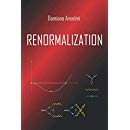Seminar given at the Department of Physics and Astronomy of the University of Bologna on May 30th, 2019
A new quantization prescription is able to endow quantum field theory with a new type of “particle”, the fakeon (fake particle), which mediates interactions, but cannot be observed. A massive fakeon of spin 2 (together with a scalar field) allows us to build a theory of quantum gravity that is both renormalizable and unitary, and to some extent unique. After presenting the general properties of this theory, I discuss its classical limit, which carries important remnants of the fakeon quantization prescription. I also discuss the possibility that the Higgs boson might be a fakeon.
We point out the idea that, at small scales, gravity can be described by the standard degrees of freedom of general relativity, plus a scalar particle and a degree of freedom of a new type: the fakeon. This possibility leads to fundamental implications in understanding gravitational force at quantum level as well as phenomenological consequences in the corresponding classical theory.
Int. J. Mod. Phys. D 28 (2019) 1944007 | DOI: 10.1142/S0218271819440073
Talk given at the conference Hot topics in modern cosmology. Spontaneous Workshop XIII, 5 – 11 May 2019 — IESC, Cargèse
A new quantization prescription is able to endow quantum field theory with a new type of “particle”, the fakeon (fake particle), which mediates interactions, but cannot be observed. A massive fakeon of spin 2 (together with a scalar field) allows us to build a theory of quantum gravity that is both renormalizable and unitary, and to some extent unique. After presenting the general properties of this theory, I discuss its classical limit, which carries important remnants of the fakeon quantization prescription and reveals unforeseen features.
Talk given at the conference PAFT 2019 – Current problems in theoretical physics. Aspects of nonperturbative QFT, foundations of quantum theory, quantum spacetime. XXV edition, Vietri sul Mare (Salerno, Italy), April 13-17, 2019
A new quantization prescription is able to endow quantum field theory with a new type of “particle”, the fakeon (fake particle), which mediates interactions, but cannot be observed. A massive fakeon of spin 2 (together with a scalar field) allows us to build a theory of quantum gravity that is both renormalizable and unitary, and to some extent unique. After presenting the general properties of this theory, I discuss its classical limit, which carries important remnants of the fakeon quantization prescription and reveals unforeseen features.
Presentazione per il pubblico alla conferenza “Tantrismo e Metafisica quantica” per il ciclo “One World University: incontri tra Oriente e Occidente”, a cura di Gloria Germani, presso in Cinema Odeon di Firenze, 21/3/2019
Talk given at the Conference “Scale invariance in particle physics and cosmology“, CERN, on January 29th, 2019
A new quantization prescription is able to endow quantum field theory with a new type of “particle”, the fakeon (fake particle), which mediates interactions, but cannot be observed. A massive fakeon of spin 2 (together with a scalar field) allows us to build a theory of quantum gravity that is both renormalizable and unitary, and to some extent unique. After presenting the general properties of this theory, I discuss its classical limit, which carries important remnants of the fakeon quantization prescription.
Under certain assumptions, it is possible to make sense of higher derivative theories by quantizing the unwanted degrees of freedom as fakeons, which are later projected away. Then the true classical limit is obtained by classicizing the quantum theory. Since quantum field theory is formulated perturbatively, the classicization is also perturbative. After deriving a number of properties in a general setting, we consider the theory of quantum gravity that emerges from the fakeon idea and study its classicization, focusing on the FLRW metric. We point out cases where the fakeon projection can be handled exactly, which include radiation, the vacuum energy density and the combination of the two, and cases where it cannot, which include dust. Generically, the classical limit shares many features with the quantum theory it comes from, including the impossibility to write down complete, “exact” field equations, to the extent that asymptotic series and nonperturbative effects come into play.
J. High Energy Phys. 04 (2019) 61 | DOI: 10.1007/JHEP04(2019)061
Talk given at the Department of Physics and Astronomy of Southampton University, UK, on Nov 16th, 2018
I introduce the concept of fake particle and study how it is used to formulate a consistent theory of quantum gravity. Fakeons arise from a new quantization prescription, alternative to the Feynman one, for the poles of higher-derivative theories, which avoids the problem of ghosts. The fake particles mediate interactions and simulate true particles in many situations. Nevertheless, they are not asymptotic states and cannot be detected directly. The Wick rotation and the S matrix are regionwise analytic and the amplitudes can be calculated in all regions starting from the Euclidean one by means of an unambiguous, but nonanalytic operation. By reconciling renormalizability and unitarity in higher-derivative theories, the models containing both true and fake particles are good candidates to explain quantum gravity. In pole position is the unique theory that is strictly renormalizable. One of the major physical predictions due to the fakeons is the violation of microcausality. I discuss the classical limit of the theory and the acausal corrections to the Einstein equations.
Several particles are not observed directly, but only through their decay products. We consider the possibility that they might be fakeons, i.e. fake particles, which mediate interactions but are not asymptotic states. A crucial role to determine the true nature of a particle is played by the imaginary parts of the one-loop radiative corrections, which are affected in nontrivial ways by the presence of fakeons in the loop. The knowledge we have today is sufficient to prove that most non directly observed particles are true physical particles. However, in the case of the Higgs boson the possibility that it might be a fakeon remains open. The issue can be resolved by means of precision measurements in existing and future accelerators.
Mod. Phys. Lett. A 34 (2019) 1950123 | DOI: 10.1142/S0217732319501232

 Quantum Gravity
Quantum Gravity 


